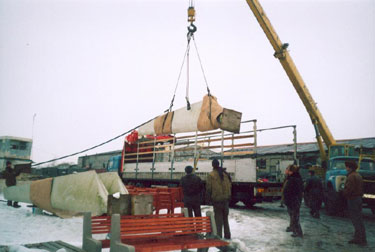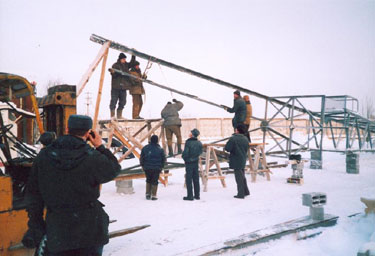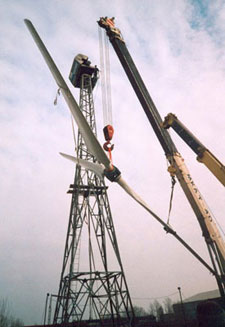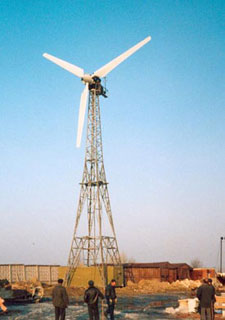Tiempo Climate Cyberlibrary
New Life for Used Wind Turbines
 |
Svetlana Volchek describes the innovative
transfer of used wind turbines from Denmark to Russia
to kickstart an indigenous wind energy
industry.
|
|
The author is a former PhD student at the St.
Petersburg Technical University. She is presently a
student at Aalborg Universit in the Sustainable
Energy Engineering Master of Science
programme.
|
Over the past five years, the Danish government has
supported increases in the size of wind turbines in the
country. Smaller wind turbines were taken down even though
these turbines were operating successfully.
As a result, a number of second-hand wind turbines have
become available in Denmark that can work well for another
ten to twelve years. Refurbishing these turbines and
installing them in Russia is a more cost-effective method
of introducing wind turbine technology than the purchase of
new wind turbines.
The St. Petersburg and Leningrad regions in Russia have
high wind speeds and a considerable potential for the
implementation of wind energy technology. In 2001, there
was a good opportunity for realizing a project to integrate
a wind turbine into the energy supply of an industrial
company in St. Petersburg. Private financing made it
possible to undertake the project, based on one of the used
wind turbines from Denmark.
A private company, Krasnoe, and the St. Petersburg State
Technical University were the initiators of the project,
which included the buying and installation of the used
Danish wind turbine - the Wind Matic 75 kW.
|

|
Arrival of Wind
Matic in St Petersburg
© Svetlana Volchek
|
The Danish
Folkecenter for Renewable Energy supported the project.
It also assisted in selecting, purchasing, and packing the
wind turbine, and contributed a new computer for
integration into the original control system.
The wind turbine Wind Matic was bought by the
company Krasnoe in Denmark after 13 years of operation.
This was an experimental project on the basis of which all
questions regarding the optimal exploitation of such wind
power plants could be resolved.
Krasnoe, who produce different kinds of building
materials, decided to install the turbine on their own
premises to reduce their energy expenses. At the same time,
their own consumption of the electricity was and still is
the only way to make the project feasible, since there is
no payment for power fed into the Russian grid.
When we started realization of this project, we expected
various problems - they began to appear immediately. This
kind of equipment has never been delivered before in
Leningrad oblast. Therefore, nobody knew clearly the
mechanism of conveyance and customs requirements.
We were taking the first steps on this path as pioneers,
and of course we faced risks. For instance, the contract
for buying the wind turbine was changed five times in order
to meet the requirements of customs.
|

|
Assembling the
tower
© Svetlana Volchek
|
Finally, after overcoming the customs barriers, we got
Wind Matic together with new challenges. The workers
who were going to install the wind turbine knew only that
this machine could produce electricity by using wind. This
was all they knew. At this stage of the project,
Folkecenter for Renewable Energy was our consultant, and
provided training and complete technical know-how for
installation, operation, and maintenance.
The transfer of know-how partly took place when we were
in Denmark, and continued during the following
implementation phase. In this way, we could educate the
group of people involved in this project. They did all of
the work, starting with building the foundation, then
integrating the new computer into the control system, and
finishing by putting the Wind Matic into
operation.
|

|
Installing the
rotor
© Svetlana Volchek
|
After all of the complications introduced by the lack of
on-site experience with the installation of such equipment
were overcome, the wind turbine successfully started
operation on 26 April 2002. The period from agreement with
seller to installation of the wind turbine in St.
Petersburg was ten months.
After one year of successful operation, calculations
showed that the average energy savings during the summer
period were 27 %, while the energy savings during the
winter period, when the wind speeds are higher, were around
45%. Economic calculations show that the pay back time for
the wind turbine is 4.5 years at the present cost of
electricity.
|

|
Ready for operation
© Svetlana Volchek
|
The project was presented as one of the contribution
from Leningrad Oblast at the national energy-savings
competition in Moscow in 2003. Both Krasnoe and the St.
Petersburg State Technical University received awards.
This first experience helped us to buy the next wind
turbine, Vestas V19 90 kW, in Denmark. The wind
turbine was installed in 2003 for a private investor, also
in the St. Petersburg region. The third wind turbine is
already in St. Petersburg, and will be installed in the
near future.
Further information
Email: svetlana.volchek@mail.dk.
On the Web
A report on a Danish Folkecenter for Renewable Energy
wind power project in Kaliningrad, Russia, is available
in Acrobat format (1.2Mb download). Visit WindturbineWarehouse.com
for details of refurbished wind turbines, including
recycled Danish turbines.
Acknowledgement
This article is reproduced from Sustainable Energy
News by permission of the author and editors.
Sustainable Energy News is published by the International Network for
Sustainable Energy (INFORSE).




